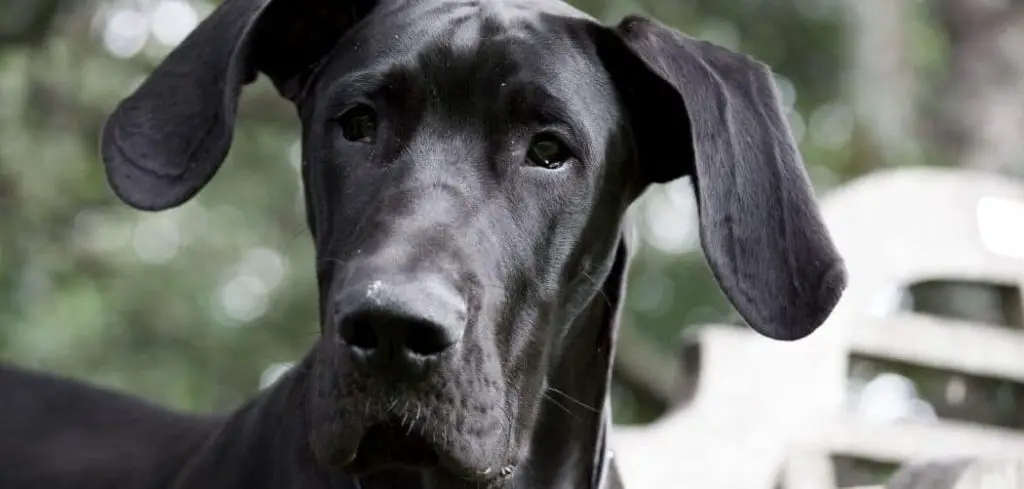Great Danes are majestic, affectionate, and loyal companions, but like many large breeds, they can develop health issues, including urinary incontinence.
If your Great Dane is having accidents indoors, leaking urine while sleeping, or frequently licking their private area, it may be experiencing incontinence.
Understanding the causes and solutions can help you manage this condition effectively and improve your dog’s quality of life.
What is Urinary Incontinence in Great Danes?
Urinary incontinence in Great Danes is the involuntary loss of bladder control, leading to urine leakage.
This issue can occur in dogs of any age but is more common in older dogs, females, and those with underlying health problems.
If left untreated, it can lead to skin infections, discomfort, and behavioral issues.
Common Causes of Incontinence in Great Danes

1. Hormonal Imbalance (Spay Incontinence in Female Great Danes)
One of the most common causes of incontinence in spayed female Great Danes is estrogen-responsive urinary incontinence.
When a female dog is spayed, the removal of the ovaries leads to a decrease in estrogen levels, which can weaken the urethral sphincter.
This results in urine leakage, especially when the dog is relaxed or sleeping.
Signs of Hormonal Incontinence:
Urine spots where the dog sleeps
Dribbling urine when relaxed
Increased licking of the genital area
2. Urinary Tract Infections (UTIs) in Great Danes
A urinary tract infection (UTI) can cause frequent urination, urgency, and even incontinence in Great Danes.
UTIs occur when bacteria enter the urinary tract, leading to inflammation and irritation of the bladder.
Symptoms of UTIs in Great Danes:
Straining to urinate
Blood in urine
Frequent urination in small amounts
Strong-smelling urine
Related: How to house train a Great Dane puppy
3. Neurological Disorders Affecting Bladder Control
Neurological issues such as spinal injuries, degenerative myelopathy, or intervertebral disc disease can impact the nerves that control bladder function.
Since Great Danes are prone to spinal problems due to their size and structure, any injury or neurological disorder can contribute to incontinence.
Signs of Neurological Bladder Issues:
Weak hind legs
Difficulty standing or walking
Loss of bladder control without awareness
4. Bladder Stones or Kidney Disease
Bladder stones and kidney disease can both cause incontinence in Great Danes.
These conditions may lead to increased urgency to urinate, discomfort, and accidental leakage.
Symptoms of Bladder Stones and Kidney Disease:
Painful urination
Increased thirst and urination
Blood in urine
Lethargy
Related: Why Is my Great Dane Pooping in the House? (Here’s Why)
5. Weak Bladder Muscles Due to Aging
As Great Danes age, their bladder muscles weaken, making it harder for them to hold urine for long periods.
This is a natural part of the aging process, but it can be managed with the right treatment and lifestyle adjustments.
6. Congenital Defects Such as Ectopic Ureter
Some Great Danes are born with anatomical abnormalities like ectopic ureters, where the tubes that carry urine from the kidneys to the bladder are misplaced.
This can cause persistent urinary leakage from a young age.
Symptoms of Congenital Urinary Issues:
Constant urine dribbling
Wet fur around genital area
Increased risk of infections
How to Manage and Treat Incontinence in Great Danes
1. Veterinary Diagnosis and Testing
If your Great Dane is experiencing incontinence, the first step is a thorough examination by a veterinarian. This may include:
Urinalysis to check for infections
Blood tests to assess kidney function
Ultrasound or X-rays to detect bladder stones or abnormalities
Neurological examination for spinal issues
2. Medications for Urinary Incontinence
Depending on the underlying cause, your vet may prescribe medications such as:
Phenylpropanolamine (PPA): Strengthens bladder sphincter muscles.
Hormone therapy (Estrogen supplements): Helps with spay incontinence in females.
Antibiotics: If a UTI is present.
Pain relief or anti-inflammatory drugs: For bladder stones or spinal conditions.
3. Dietary Changes to Support Bladder Health
Feeding your Great Dane a diet that promotes urinary health can help manage incontinence.
Some dietary recommendations include:
Moist food or increased water intake to dilute urine and prevent irritation.
Cranberry supplements to reduce UTI risk.
Prescription urinary diets if your vet recommends one for bladder stones or kidney issues.
4. Managing Your Great Dane’s Environment
To keep your home clean and your dog comfortable:
Use waterproof bedding to prevent urine stains and odors.
Provide frequent potty breaks to reduce accidents.
Consider using dog diapers or belly bands for severe cases.
5. Surgery for Anatomical Issues
For congenital defects like ectopic ureters, surgery may be the best solution to correct the abnormality and stop involuntary urination.
Preventing Incontinence in Great Danes
While some causes of incontinence cannot be prevented, you can take steps to minimize risks:
Maintain a healthy weight: Extra weight puts pressure on the bladder and can contribute to incontinence. Ensure your Great Dane has a balanced diet and regular exercise to stay fit.
Regular vet check-ups: Routine check-ups help detect early signs of bladder, kidney, or neurological issues before they become severe.
Proper hydration: Provide plenty of fresh water to prevent dehydration and reduce the risk of urinary tract infections and bladder stones.
Bladder-strengthening exercises: Encourage regular outdoor breaks to maintain strong bladder control and prevent accidents due to weak muscles.
Avoid exposure to toxins: Certain toxins, like those found in household cleaners, can negatively impact kidney function, potentially leading to incontinence.
Monitor hormone levels in spayed females: If your female Great Dane is spayed, consult your vet about hormone therapy options to prevent estrogen-responsive incontinence.
Ensure a stress-free environment: Stress and anxiety can contribute to incontinence by weakening bladder control. Maintain a calm, structured environment with plenty of mental and physical stimulation.
Key Takeaway
Urinary incontinence in Great Danes can be distressing for both the dog and its owner, but with the right approach, it is manageable.
Identifying the cause early, working with your veterinarian, and implementing lifestyle changes can significantly improve your Great Dane’s comfort and well-being.
Sources:
